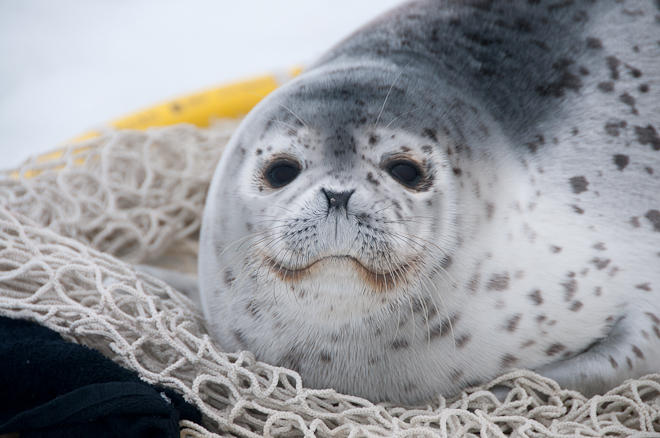Spotted seal (Phoca largha)
Spotted seals form family groups consisting a female, male and a pup during their breeding season. This is unusual amongst most true seal species. Read more about spotted seals on NOAA Fisheries' website.

Photo Credit: Dave Withrow (NOAA), Alaska Fisheries Science Center, NOAA Fisheries Service; Marine Mammal Permit: 15126
Chromosome-length genome assembly
Download the Phoca_largha_HiC.fasta.gz file containing the chromosome-length (2n=32) assembly of the spotted seal genome. All modifications with respect to the draft (see below) are annotated in the Phoca_largha_HiC.assembly file. Some basic stats associated with the new reference, Phoca_largha_HiC, are listed below. The full data release can be explored here.
Contig length (bp) | Number of contigs | Contig N50 (bp) | Longest contig (bp) |
|---|---|---|---|
2,344,390,371 | 299,852 | 55,513 | 546,633 |
Scaffold length (bp) | Number of scaffolds | Scaffold N50 (bp) | Longest scaffold (bp) |
|---|---|---|---|
2,360,989,671 | 249,399 | 142,074,308 | 197,902,499 |
Draft
The chromosome-length genome assembly is based on the draft assembly Phoca_largha, credited below.
The draft assembly was generated by the DNA Zoo team from short insert-size PCR-free DNA-Seq data using w2rap-contigger (Clavijo et al. 2017), see (Dudchenko et al., 2018) for details. This work was performed under Marine Mammal Health and Stranding Response Program (MMHSRP) Permit No. 18786-03 issued by the National Marine Fisheries Service (NMFS) under the authority of the Marine Mammal Protection Act (MMPA) and Endangered Species Act (ESA). The specimen used in this study was collected by NOAA Wayne McFee and provided by the National Marine Mammal Tissue Bank, which is maintained by the National Institute of Standards and Technology (NIST) in the NIST Biorepository, and which is operated under the direction of NMFS with the collaboration of USGS, USFWS, MMS, and NIST through the Marine Mammal Health and Stranding Response Program.
Method
3D Assembly was performed using 3D-DNA pipeline (Dudchenko et al., Science, 2017). The genome was reviewed using Juicebox Assembly Tools (Dudchenko et al., bioRxiv, 2018). See Methods for more information.
Hi-C sample
The kidney sample for in situ Hi-C preparation was donated by a female individual, and obtained from National Marine Mammal Tissue Bank maintained by the National Institute of Standards and Technology (NIST) in the NIST Biorepository.
Hi-C Contact maps
Hi-C data was aligned to the draft reference using Juicer (Durand, Shamim et al., Cell Systems, 2016), and contact maps visualizing the alignments with respect to the draft and the new reference were built using 3D-DNA (Dudchenko et al., Science, 2017). The contact maps can be explored below via Juicebox.js interactive tool (Robinson et al., Cell Systems, 2018). (Please note that the interactive figures are scaled 1:2.) To explore the assembly in greater detail, please download the .hic and .assembly files from the data release folder and use Juicebox Assembly Tools (Dudchenko et al., bioRxiv, 2018).
References
If you use this genome assembly in your research, please check that the conditions of use associated with the draft permit it, and acknowledge the following work.
The draft assembly was generated by the DNA Zoo team from short insert-size PCR-free DNA-Seq data using w2rap-contigger (Clavijo et al. 2017), see (Dudchenko et al., 2018) for details. This work was performed under Marine Mammal Health and Stranding Response Program (MMHSRP) Permit No. 18786-03 issued by the National Marine Fisheries Service (NMFS) under the authority of the Marine Mammal Protection Act (MMPA) and Endangered Species Act (ESA). The specimen used in this study was collected by NOAA Wayne McFee and provided by the National Marine Mammal Tissue Bank, which is maintained by the National Institute of Standards and Technology (NIST) in the NIST Biorepository, and which is operated under the direction of NMFS with the collaboration of USGS, USFWS, MMS, and NIST through the Marine Mammal Health and Stranding Response Program.
Dudchenko, O., Batra, S.S., Omer, A.D., Nyquist, S.K., Hoeger, M., Durand, N.C., Shamim, M.S., Machol, I., Lander, E.S., Aiden, A.P., Aiden, E.L., 2017. De novo assembly of the Aedes aegypti genome using Hi-C yields chromosome-length scaffolds. Science 356, 92–95. https://doi.org/10.1126/science.aal3327.
Dudchenko, O., Shamim, M.S., Batra, S., Durand, N.C., Musial, N.T., Mostofa, R., Pham, M., Hilaire, B.G.S., Yao, W., Stamenova, E., Hoeger, M., Nyquist, S.K., Korchina, V., Pletch, K., Flanagan, J.P., Tomaszewicz, A., McAloose, D., Estrada, C.P., Novak, B.J., Omer, A.D., Aiden, E.L., 2018. The Juicebox Assembly Tools module facilitates de novo assembly of mammalian genomes with chromosome-length scaffolds for under $1000. bioRxiv 254797. https://doi.org/10.1101/254797.
Disclaimer
This is a work in progress. If you notice any discrepancies in the map or have data that confirms or contradicts the suggested reference, please email us at thednazoo@gmail.com or leave a comment on the Forum.
